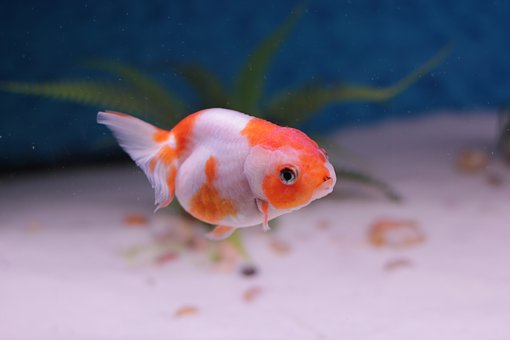Many Goldfish keepers are unaware that the highly selected Asian “carps” are very well suited for warmer waters. Ranchus, Orandas, Bubble eyes, etc all do better in heated systems, e.g. 74-78 degrees at a minimum, which *might* mandate a heater, especially during the winter.

The problems you can encounter with Goldfish kept too cool include:
- Increased susceptibility to bacterial infection,
- Increased incidence of irreconcilable Dropsey or floater diseases; where the fish floats helplessly at an unusual angle, even upside-down!
- Filter bacteria in cooler systems do not function well, and ammonia problems may result.
All in all, you will only enhance th health of the fish and the function of the aquarium when you heat it up, as I said, 74 degrees minimum.
Goldfish success in seven easy steps:
1. Undergravel filter or sponge filter. (My favorite sponge filter)
2. Partial waterchanges weekly (Or trickle!)
3. pH supported above 7.2
4. Temperature 74 degrees or warmer (Best heaters EVER)
5. Live plants whenever possible (Apon, Anubias, floating Wisteria, Duckweed)
6. Turbulence but more importantly, high aeration are a must. Silent tanks spell death. This is VERY important.
7. Salt at the first sign of trouble. 0.3%
Invest in at least a ten or twenty gallon system.
- Filtrate with an Undergravel plate driven by a single powerhead. Or, use a sponge filter (Click).
- If used, make sure the powerhead runs Venturi-style, which aerates well.
- Make sure the pH is ‘buffered’ to neutral, there are chemicals for this. One such compound which is readily available and cheap is SeaChem’s Neutral Regulator.
- Invest in some live plants. **Aponegeton**, Anubias, Cryptocoryne, Pennywort, etc are all good ones.
Anachris, Cabomba etc are a little messy, and like cooler water. - Feed a good small pelleted food like *Hikari Lionhead Sinking Pellets* no more than twice per day.
- Perform water changes every week or every other week – or TRICKLE new water all the time (best).
- Use a siphon hose to clean the gravel periodically.
Did you know that a Goldfish can grow to be 8 inches long in a single season (one year) if fed well and given enough space?
Goldfish Care and Success: Filters
“I Heard undergravel filters were bad!”
 In the olden days, Undergravel filters were driven by airpumps. People had little idea about good water quality and if the water looked clear, it was “good.” Ages ago, people with undergravel filters left them alone for years at a time, and over time, the gravel would stagnate with toxic amounts of mulm and gas – Nowadays we understand that toxic gases can be made in stale gravel beds and these gasses can invisibly kill our fish. The key to using an undergravel filter successfully is to keep the gravel siphon-cleaned on a semi regular basis.
In the olden days, Undergravel filters were driven by airpumps. People had little idea about good water quality and if the water looked clear, it was “good.” Ages ago, people with undergravel filters left them alone for years at a time, and over time, the gravel would stagnate with toxic amounts of mulm and gas – Nowadays we understand that toxic gases can be made in stale gravel beds and these gasses can invisibly kill our fish. The key to using an undergravel filter successfully is to keep the gravel siphon-cleaned on a semi regular basis.
Still, there are arcane hold outs who still believe that Undergravel filters, even when properly employed, are dangerous and can result in toxin production. Whatever.
Then, instead of using an Undergravel filter plate, which at the very least keeps *some* water moving through the gravel, the poor hobbyist *eschews* the Undergravel filter and then suffers the fish on two inches of deadspace gravel with no circulation.
Consider the following on Undergravels:
Message-ID: <950824095530_62169xxxxxxmail.aol.com>
To: 76102.11xx@compuserve.com
Subject: Goldies update
Erik-
Just as your article stated, after 24 hours of undergravel in place, a transformation beyond anything I have ever seen was evident.
The energy level of Goldies was increased, the clarity of water increased (although I did think it was clear before) their appetite increased, their colors were more vibrant, even the ulceration on Blackie had almost disappeared!
Ok, ok, 50 lashes with a wet noodle for me!
I regret not installing the undergravel sooner- I probably would not have lost my Ranchu or Fantails. Me a culpa.
I’m telling all my fish buddies to install their UG’s before it’s too late.
Your expertise has proven to be invaluable.
The Use of Salt as a Remedy
The following, on salt, is included because for a goldfish-beginner this should be your knee-jerk reaction to goldfish getting sick, once you’ve checked your water and proven the pH is okay.
I recommend that you use salt, before you try anything else for parasites.
I recommend salt so darn often because it has so many benefits over other medicants. Namely:
1) It does not harm the majority of fish species.
2) It rarely pushes sick fish “over the edge.”
3) It eliminates, QUICKLY, 5 of 7 ciliates I can easily recall.
4) It does not get bound out of the system by organics or sunlight.
5) It does not pose a health risk to humans contacting it.
6) It is CHEAP, CHEAP, CHEAP.
and 7) It WON’T harm your filter!
Salt knocks off the following baddies:
Ichthyophthirius
Chilodinella
50% of Costiasis (Ichthyobodo necatrix)
Almost every single Trichodiniid/Tripartiella organism.
Glossatella
Scyphidia
Epistylis
Trichophrya
External Tetrahymena
Inhibits trematode reproduction, clears 30% of adults.
Salt: Remove submerged plants. Perform a fifty percent waterchange if possible, and clean the tank as well as reasonably possible without causing undue delay in treatment. This is because after you apply salt, you should probably leave it in for a little over a week – meaning you won’t be doing consequential water changes AFTER application.
Apply one teaspoon of iodized-or-not-doesn’t-matter table salt per gallon of water every 12 hours for three treatments (3 tsp per gallon). Alternatively, for larger systems, dose one pound per hundred gallons of water every 12 hours for three treatments (3 pounds per hundred gallons). Add all at once in the case of epidemic mortality.
A word of caution on SALT though. It should be food-grade or non mineralized cattle feed grade. It should have no additives like Yellow Prussiate of Soda, (YPS) and it should not be a “trace-mineralized” feed grade salt. Further, it should be avoided when native South American fish are involved, eg: Brochis britskii cats, and native or wild caught Discus. Rams dislike it also. Figure if a fish was wild caught in the Amazon, it shouldn’t be salted.
Almost all submerged plants perish in the salt dose listed above.
Do not use salt if you value your live plants.
Note the divided dosing, so as not to add it all at once. It’s less disruptive to the fish when added over 36 hours.







